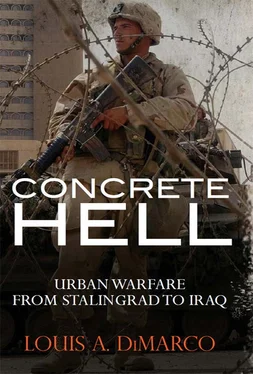As in all previous urban operations, intelligence was a key to success. The battle for Jenin demonstrated how difficult it is, for even an excellent intelligence service like that of the IDF, to penetrate into a hostile urban environment and accurately determine important tactical details. Remote sensors in the form of unmanned aerial vehicles (UAVs) greatly increased the tactical situational awareness of IDF commanders and allowed them to shift forces to meet threats. As the battle progressed, intelligence support to the attacking Israeli ground forces improved. This was because the IDF created tactical interrogation units that questioned captured militants and civilians as soon as they came under IDF control. These intelligence units were organized to both send the acquired information up the chain of command, and — importantly — quickly send new and important information directly back to the units in combat.
A final important aspect of the Israeli success in the urban battle of Operation Defensive Shieldwas the use of special forces. The Israelis employed relatively large numbers of special forces to the urban battles of March and April 2002, particularly the operations in Nablus and Jenin. These included the reconnaissance companies of each brigade which were trained in special forces tactics such as sniping and covert reconnaissance. Thus, the defending Palestinians had to not only contend with brute force conventional threats like the D9 bulldozers and Merkava tanks, but also the equally deadly special forces snipers and raiders.
The D9 dozer was a new urban weapon employed by the IDF. On the Palestinian side they employed an old weapon, the booby-trapped IED, but they did so in unprecedented numbers. With just a little time to prepare, the militants were able to distribute thousands of devices, and in doing so they significantly slowed the advance of the IDF infantry. IDF engineers, both dozer operators and explosive ordnance disposal (EOD) specialists, were critical to maintaining the momentum of the attack. The IDF learned that they did not have enough specialist EOD personnel, and thus after the battle they increased the emphasis on EOD training among their infantry.
Though the IDF was sensitive to civilian casualties, and no massacre occurred in Jenin, it is important to understand the type of military operation that the IDF was tasked to accomplish during Operation Defensive Shield. By going into the urban areas of the West Bank, the IDF was invading the urban centers of a foreign, and generally hostile, population. The West Bank was not part of Israel, and at the time of the operation it was under the political control of the Palestinian Authority. Thus, the operational context was more like the Russian army in Grozny than the British in Northern Ireland or even the French in Algeria. In both the latter cases, the military had the objective of eliminating the urban enemy while at the same time not alienating the urban population, who were citizens of the United Kingdom and France respectively. The IDF’s operational concern with civilian casualties was more out of respect for the law of war and international opinion, than the military and political objectives of the campaign. Thus, they were comfortable emphasizing speed, firepower, and armored forces, and destroying as many buildings as necessary to achieve the military objective, as long as the laws of war were observed. Thus, the IDF perspective of the battle was as a battle against a security threat to Israel. The enemy was a guerrilla force hiding among a sympathetic enemy population in a foreign city.
For their part, the Palestinian defenders, though hopelessly overmatched by Israeli military power, demonstrated — as the Chechen fighters had — that adroit manipulation of the information spectrum could yield some positive strategic results even when the outcome of the conventional military battle was a foregone conclusion. The Palestinians were aided in this by the Israeli forces, who demonstrated no understanding of the vital importance of engaging the enemy in the information spectrum of war.
The Palestinian capacity for attacking Israel was significantly diminished by the urban battles of 2002, but not eliminated. The battles were not meant to, and the IDF was not capable of, eliminating the reasons behind the Intifada. Therefore, as soon as the IDF withdrew, and the militants acquired and trained new recruits, the Intifada continued. The Israeli–Palestinian war would not end until 2005. The best that Operation Defensive Shield could accomplish was reducing the Palestinian militants’ capability to conduct terrorist attacks inside Israel. It accomplished that goal and therefore was a successful operation.
CHAPTER 10
SYSTEMATIC URBAN WARFARE
“Ready First” in Ramadi, 2006–07
When the 1st Brigade Combat Team (1BCT) of the US Army’s 1st Armored Division (AD) received its orders sending it into western Iraq in June 2006, it was one of a long list of army and US Marine combat units assigned to operations in Iraq’s Al-Anbar Province since the US invasion of Iraq in March 2003. There was no reason to believe at the time that the operations of the “Ready First” Brigade in the provincial capital of Ramadi would be any more decisive or exceptional than the operations of previous units. What happened in the next nine months, however, became the greatest success story of US arms to come out of Operation Iraqi Freedom. Between the summer of 2006 and the spring of 2007, the deadliest city in the most dangerous anti-US province in Iraq was not just pacified, but became the model for successful urban counterinsurgency for the rest of the war in Iraq, as well as for operations in Afghanistan.
A Hotbed of Anti-Americanism
The US military came to Al-Anbar province in the last days of the initial invasion of Iraq, known as Operation Iraqi Freedom One (OIF1). Al-Anbar was far from what the US command viewed as the decisive point of the operation, the city of Baghdad, and so it was not critical to the invasion. The only decisive combat action that took place in the province in the initial weeks of the war was the seizure of the Hadithah Dam by the US Army’s 3rd Battalion, 75th Ranger Regiment. It took the Americans several months to realize the unique significance of Al-Anbar Province.
Al-Anbar Province, with a population of 1.23 million people, was the largest province geographically in Iraq, and was the only province dominated by Sunni Muslims, who comprised 95 percent of the population. Because it was dominated by Sunni Arabs, the province was favored by Saddam Hussein, and was a bastion of Ba’ath party support. It was also home to a large percentage of the Iraqi army’s leadership. Because of its close affiliation with the Ba’ath Party and the army, and also because it was relatively untouched by the initial invasion and thus not exposed to the capabilities of the US military, it became the natural refuge of those fleeing Baghdad and bent on resisting the American occupation of Iraq.
Al-Anbar Province was the largest in Iraq, at 53,370 square miles, about the size of the American state of North Carolina, and it was located in the southwest corner of Iraq. The vast majority of the southern portion of the province was part of the Syrian Desert, which extended across the province’s borders westward into Syria and south into Jordan and Saudi Arabia. The northern fifth of the province was a strip of land to the north and south of the Euphrates River. This strip includes the major cities of the province, the agricultural areas, the history, and the bulk of the population. The two largest cities of the province, Fallujah and Ramadi, were located in this area.
Читать дальше












